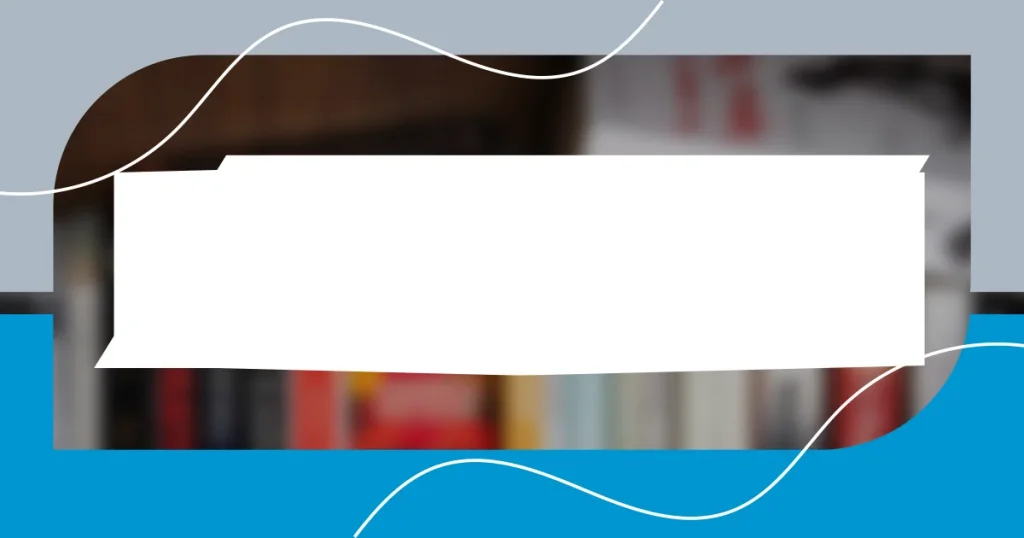Key takeaways:
- Understanding genre expectations is essential for writers to create compelling stories that resonate with readers, allowing for creativity within established tropes.
- Identifying and embracing one’s unique voice through personal experiences and experimentation fosters genuine connections with the audience.
- Effectively structuring narratives and engaging with audience expectations through pacing and clever twists enhances the overall storytelling experience.

Understanding genre expectations
Understanding genre expectations is crucial for any writer navigating the literary landscape. I remember when I first tried my hand at writing a romance novel. I thought I could deviate from the classic love story structure, but soon realized readers expect certain tropes, like the ‘meet-cute’ or the grand romantic gesture. It’s intriguing to ponder—how do we meet our readers halfway while still injecting our unique voices into the work?
When I dive into a new genre, I often ask myself what emotions the genre typically evokes. For instance, fantasy often elicits wonder and adventure, while thrillers may heighten suspense and fear. In my experience, these expectations can serve as a compass, guiding my writing while also providing room for creativity. So, could it be that understanding these conventions not only sharpens our storytelling skills but also makes our stories resonate more deeply with our audience?
Each genre has its unwritten rules. I once dealt with this firsthand while writing a mystery. Initially, I was reluctant to follow the usual red herrings and plot twists, thinking I could be inventive. However, once I embraced these elements, the story flowed organically, and the tension readers crave became palpable. Isn’t it fascinating how genre expectations can transform our narratives into seamless journeys for our readers?

Identifying your unique voice
Finding your unique voice in writing is a journey that can sometimes feel daunting. I remember feeling lost at first, trying to mimic writers I admired. It wasn’t until I poured my own experiences into my characters and narratives that I discovered a style that felt authentically mine. Recognizing what makes your perspective unique is key. I often reflect on the moments that have shaped me—those raw emotions and personal stories become the bedrock of my voice.
To help identify your unique voice, consider these introspective strategies:
- Reflect on Personal Experiences: What moments shaped who you are?
- Experiment with Style: Try different genres or perspectives until something clicks.
- Listen Actively: Pay attention to how others express themselves and find inspiration.
- Journal Your Thoughts: Writing without constraints can reveal patterns or themes inherent to your voice.
- Embrace Imperfections: Sometimes vulnerability in your writing will resonate more than polished perfection.
These exercises have opened doors for me, allowing my words to flow more naturally and connect with readers in a way that feels genuine.

Researching popular genre trends
Researching genre trends is a vital step in writing that resonates with readers. I recall scouring bestseller lists and popular book blogs to see what themes were capturing audiences’ imaginations. This experience taught me that staying updated on genre trends not only informs my writing but also helps me connect with readers by acknowledging their preferences. Have you ever noticed how certain tropes seem to surge in popularity, like the rise of cozy mysteries? Recognizing these patterns can be a game-changer.
One of my favorite ways to engage with genre trends is by participating in online writing communities. I often find discussions about current fads and reader expectations enlightening. For example, forums dedicated to romance writing provide insights into what readers are loving at the moment—whether it’s slow-burn relationships or inclusive narratives. This feedback loop between writers and reading audiences has significantly influenced my approach to genre, reminding me that the conversation is ever-evolving.
Conducting a simple analysis of the stories topping the charts can provide more clarity. By examining cover design, themes, and character arcs, I can see shared elements that indicate reader preferences. For instance, during my research for a fantasy novel, I found that strong female protagonists were increasingly trending. This realization pushed me to develop a character that aligned with that new wave, ensuring my story would resonate in a market craving such narratives.
| Genre | Current Trends |
|---|---|
| Romance | Slow-burn relationships, diverse characters |
| Fantasy | Strong female leads, magical realism |
| Mystery | Cozy settings, amateur sleuths |

Blending genres effectively
Blending genres can be a thrilling yet challenging endeavor. I often find myself experimenting with different elements to see what feels right. For instance, when I combined elements of fantasy with a contemporary romantic storyline, I felt alive in a way that made my writing captivating. But the key is to ensure that both genres enhance each other rather than compete for attention.
One effective method I’ve discovered is crafting characters that resonate with both genres. I remember developing a detective who not only solves crimes but also journeys through a magical world. This duality allowed me to dive deep into themes of mystery and wonder, making my narrative richer. Have you ever tried balancing contrasting elements? Discovering how they can amplify your story’s emotional depth is nothing short of exhilarating.
It’s also about being intentional with your narrative structure. When I wrote a story blending historical fiction with a touch of sci-fi, I realized that pacing becomes crucial. I needed to weave together past events with futuristic elements seamlessly. This experience taught me that the transitions between genres should feel organic, as if they were always meant to coexist. So, what genres speak to you? Experimenting without fear can lead to some of the most rewarding storytelling experiences.

Creating compelling characters
Creating compelling characters is at the heart of any successful story, and I’ve found that authenticity plays a crucial role in this process. I vividly recall the time I crafted a character based on a friend with a unique perspective on the world. This character’s quirks and fears truly came alive on the page, making her relatable and memorable for readers. Have you ever felt like a character was just like someone you knew? That connection can transform a character into a companion for the reader.
I also believe that flawed characters tend to resonate more deeply. When I was working on a novel, I created a protagonist who was grappling with their own insecurities. I noticed how readers empathized with her struggles, often reflecting on their own challenges. That made me realize: perfect characters can feel distant, but layers of vulnerability create genuine connections. What are the imperfections that make your characters feel real? Embracing those flaws can lead to compelling narratives rich with emotional depth.
Additionally, I find that diverse backgrounds and experiences add richness to characters. In one project, I introduced a character with a unique cultural heritage, which not only shaped their personality but also influenced the plot. It opened doors to exploring themes of identity and belonging. How could you integrate diverse perspectives into your work? By weaving them thoughtfully, you create characters that are not just compelling but also reflective of the world’s complexities, making your story more relatable.

Structuring your narrative
Structuring your narrative is essential for effectively blending genres. I remember feeling overwhelmed while organizing a storyline that combined elements of horror and coming-of-age. I soon learned that establishing a clear narrative arc made a world of difference. By creating sections for exposition, rising action, climax, and resolution, I was able to balance the eerie tension of horror with the emotional growth of my characters. This structure helped the reader to engage with both aspects without feeling pulled in opposing directions.
One technique I rely on is to outline key plot points for each genre. In one particular project where I fused romance with a dystopian setting, I mapped out how each genre’s elements would interact at critical moments. This exercise clarified where I needed to heighten the emotional stakes and where I could introduce tension. Have you ever tried outlining in this way? It not only keeps you grounded but also reveals the synergy between genres, paving the way for smoother transitions.
Finally, maintaining a consistent tone throughout the narrative proves vital. During my time writing a comedic mystery, I aimed to sustain humor while gradually revealing darker secrets. The juxtaposition created a unique reading experience, yet it required careful thought on how to balance these styles without losing coherence. Can you remember a time when a sudden shift in tone took you out of a story? By being intentional about tone and alignment with genre expectations, you create a more cohesive narrative that keeps readers invested.

Engaging your audience’s expectations
Engaging your audience’s expectations involves a delicate dance between meeting and subverting those expectations. I recently tried my hand at a fantasy short story where I introduced a character who seemed like the typical hero. However, as the plot unfolded, I revealed that their greatest strength lay in their capacity for vulnerability. This unexpected twist not only captivated my readers but also encouraged them to reconsider the conventional traits of heroism. Have you ever found yourself surprised by a character’s development? It’s moments like these that keep readers on their toes.
A powerful way to engage your audience is by anticipating the tropes common to your genre and then adding your unique spin. In one of my thrillers, I incorporated a classic ‘whodunit’ setup but cleverly hid the true culprit in plain sight. By utilizing red herrings, I maintained suspense while still delivering a satisfying resolution. It’s exhilarating when readers take a breath and say, “I never saw that coming!” Isn’t it rewarding to surprise your audience in a way that enhances their experience?
Lastly, I’ve come to appreciate the importance of pacing in fulfilling audience expectations. I recall a project where I had to balance action-packed scenes with quieter, introspective moments. By carefully modulating the pace, I ensured that readers were not just entertained but also absorbed in the character’s internal journey. It’s a bit like crafting a playlist; the ebb and flow of energy can reflect the story’s emotional landscape. Have you considered how pacing affects your storytelling? Striking this balance can make your narrative feel both dynamic and authentic, deepening reader engagement.
















